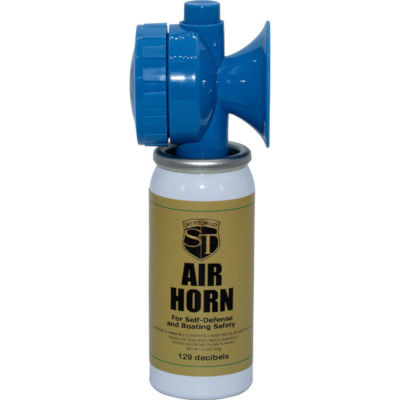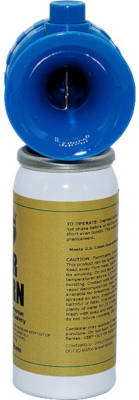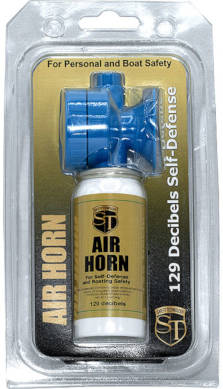Air Horn FAQ

How does an air horn work?
An air horn uses compressed air or gas to create a loud and powerful sound. Here's a simplified explanation of how it functions:
-
Air Source: Air horns require a source of compressed air or gas to generate sound. This can be provided by a built-in canister of compressed gas or an external air compressor connected to the horn.
-
Diaphragm or Reed: The air horn consists of a diaphragm or reed mechanism. When the compressed air or gas is released into the horn, it flows over the diaphragm or reed, causing it to vibrate rapidly.
-
Amplification Chamber: The vibrating diaphragm or reed is located inside an amplification chamber designed to enhance the sound produced. The chamber typically has a conical or horn-shaped structure that helps concentrate and amplify the sound waves.
-
Sound Output: As the diaphragm or reed vibrates, it pushes the surrounding air molecules, creating pressure waves that travel through the amplification chamber and exit through the horn's opening. The shape and design of the horn help direct and project the sound waves forward, resulting in a loud and focused sound output.
-
Valve or Button: Air horns usually have a valve or button that controls the release of compressed air or gas into the horn. When the valve is opened, or the button is pressed, the compressed air is released, initiating the sound-producing process.
By rapidly vibrating the diaphragm or reed and channeling the resulting sound waves through the amplification chamber, an air horn produces its characteristic loud and attention-grabbing sound.
What is the history of air horns?
The history of air horns can be traced back to the development of compressed air and pneumatic systems. Here is a brief overview of their evolution:
- Early Pneumatic Systems: The concept of using compressed air for signaling and producing sound dates back centuries. Early pneumatic systems, including devices like pneumatic trumpets, were used for communication, signaling, and even in musical instruments.
- Steam Whistles: In the 19th century, steam-powered ships and trains utilized steam whistles for signaling purposes. Steam whistles produce a loud and distinctive sound by releasing high-pressure steam through a specially designed whistle mechanism.
- Transition to Air: As technology progressed, steam-powered systems were gradually replaced by compressed air systems for various applications, including signaling and safety. Compressed air was more readily available and safer to handle than high-pressure steam.
- Introduction of Air Horns: Air horns, as we recognize them today, began to emerge in the early 20th century. As powerful signaling devices, they were primarily used in marine settings, such as ships and boats. The loud and penetrating sound of air horns made them practical for alerting nearby vessels or signaling emergencies.
- Automotive Applications: Air horns found their way into the automotive industry, where they became popular for use in trucks, buses, and other large vehicles. Air horns provide a louder and more attention-grabbing alternative to traditional electric horns.
- Diverse Applications: Over time, air horns expanded their applications beyond marine and automotive settings. They became widely used in sporting events, stadiums, emergency signaling, industrial safety, and even personal safety as a bear horn.
Today, air horns continue to be used in various contexts where a loud and distinctive sound is required for signaling, safety, or attention-grabbing purposes. They have become an established part of auditory signaling systems across different industries.
How loud are air horns?
Air horns can be pretty loud, and their volume can vary depending on the specific type and model. Generally, air horns produce sound levels ranging from 120 decibels (dB) to 150 dB or more. To put that into perspective, here are some typical sound levels for reference:
- Normal conversation: around 60 dB
- Busy street traffic: approximately 70-80 dB
- Rock concert: typically 110-120 dB
- Threshold of pain: generally around 120 dB

The air horn sound can damage hearing.
Air horns are designed to produce a robust and attention-grabbing blast of sound, making them useful in various situations such as sporting events, marine applications, or emergency signaling. However, it's essential to exercise caution when using air horns, particularly in close proximity to others, as prolonged exposure to high sound levels can potentially damage hearing.
Can air horns damage hearing?
Yes, air horns have the potential to damage hearing if misused or if someone is exposed to them at close range for extended periods. Air horns are designed to produce extremely loud and intense sounds, often reaching or exceeding 120 decibels (dB) and even higher. Prolonged exposure to high sound levels can cause temporary or permanent hearing damage.
Here are a few considerations regarding the potential risks to hearing:
-
Sound Intensity: The loudness of an air horn depends on its specific model and the volume setting. Higher volume settings can generate louder sounds, increasing the risk of hearing damage.
-
Proximity: The closer someone is to the air horn when it sounds, the greater the potential for hearing damage. Being in close proximity to an air horn, particularly in an enclosed or reflective environment, can intensify the sound and increase the risk to hearing health.
-
Duration of Exposure: Continuous or repeated exposure to loud sounds from an air horn can contribute to hearing damage over time. Even short bursts of extremely loud sound can have an impact if repeated frequently.
To protect hearing when using or being exposed to air horns:
-
Use ear protection: When operating an air horn or being in an environment where air horns are used, it is advisable to wear appropriate hearing protection, such as earplugs or earmuffs, to reduce the risk of hearing damage.
-
Maintain distance: Keep a safe distance from the air horn when activated, especially if used indoors or in enclosed spaces where sound can reverberate.
-
Limit exposure time: Minimize exposure to loud air horn sounds and take breaks to give your ears a chance to recover if prolonged use is necessary.
It is crucial to exercise caution and follow safety guidelines to prevent potential hearing damage when using or being exposed to air horns or any other loud noise sources.
How long can an air horn sound continuously before it needs to be refilled or recharged?
The duration for which an air horn can sound continuously before it needs to be refilled or recharged depends on the specific design and capacity of the air horn, as well as the amount of compressed air or gas it holds. Here are some general factors to consider:
-
Canister Capacity: Air horns typically have a canister or reservoir that stores the compressed air or gas. The larger the capacity of the canister, the longer the air horn can sound before needing a refill or recharge.
-
Intensity and Duration of Sound: The duration of continuous sound production also depends on the intensity and volume at which the air horn is operated. Higher volume settings may deplete the compressed air or gas more quickly.
-
Efficiency and Design: The efficiency of the air horn design can also impact its runtime. Some air horns are designed to optimize the use of compressed air, allowing for longer durations of continuous sound production.
In practical scenarios, the duration of continuous sound production can vary widely. Smaller air horns may have a limited runtime of a few seconds to a minute, while larger air horns with larger canisters can potentially produce sound for several minutes before requiring a refill or recharge. It's advisable to consult the manufacturer's instructions or specifications for specific information regarding a particular air horn model.
How far can the sound of an air horn travel?
The distance that the sound of an air horn can travel depends on various factors, including the specific type and power of the air horn, environmental conditions, and obstacles that may affect sound propagation. While it's challenging to provide an exact distance, here are some general considerations:
-
Power and Design: Air horns vary in terms of power and design. Some models are designed to produce a more focused and concentrated sound, while others may have a wider dispersion pattern. Higher-powered air horns generally have a greater potential to carry sound over longer distances.
-
Environmental Conditions: Environmental factors such as wind, temperature, humidity, and atmospheric conditions can affect sound propagation. Windy conditions, for example, can disperse sound and reduce its effective range.
-
Background Noise: The presence of other ambient sounds in the environment, such as traffic, crowd noise, or machinery, can affect the perceived audibility and range of the air horn sound.
-
Obstacles and Reflections: Buildings, trees, and other objects can obstruct and reflect sound waves, impacting how far the sound of an air horn can travel. Open spaces with minimal obstacles generally allow sound to travel further.
Considering these factors, the sound of a typical air horn can potentially carry over several hundred meters in favorable conditions. However, the effective range may be shorter in environments with high background noise or significant obstacles.
It's important to note that the primary purpose of an air horn is to provide an attention-grabbing sound in close proximity, such as on a boat, in a stadium, or for localized signaling. While the sound may carry over distances, its effectiveness diminishes as the distance increases.
Are air horns legal to use in public?
The legality of using air horns in public can vary depending on the jurisdiction and local regulations. It's important to familiarize yourself with the specific laws in your area. Air horns are allowed in many places for specific purposes such as safety signaling, emergency alerts, or sporting events. However, they may be restricted in residential areas, public spaces, or during certain hours to prevent unnecessary noise disturbances.
To ensure compliance with local laws, it is recommended to:
-
Research Local Regulations: Look up the laws and regulations about noise levels and air horns use in your specific location. This information can usually be found in local noise ordinances or traffic regulations.
-
Check Specific Use Cases: Different jurisdictions may have specific rules for using air horns in vehicles, boats, or other contexts. Determine if any restrictions or guidelines apply to your particular use case.
-
Consider Alternative Options: If air horns are not permitted or have limitations, explore alternative options for signaling or alerting, such as electric horns, sirens, or other approved devices that meet local requirements.
-
Seek Permission or Permits: In some cases, you may need to obtain permission or permits from local authorities to use air horns in certain situations, such as organized events or construction sites.
Always prioritize safety and respect for others when using air horns or any other signaling devices in public spaces.
Where Can I Buy an Air Horn?
Right here at TBOTECH! We have a 129-decibel air horn can that is great as a personal alarm or for making noise at your kids' soccer game. These are great for creating enthusiasm and recognizing your team's latest score.
Also used extensively as emergency signaling devices, they can alert others to your location to get immediate assistance.
Add your comment now!
Post Comment




